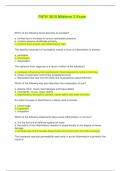Exam (elaborations)
PATH 3610 Midterm 2 Exam | Complete Solutions (Verified)
- Course
- Institution
PATH 3610 Midterm 2 Exam | Complete Solutions (Verified) Which of the following terms describe an exudate? a. formed due to increase in venous hydrostatic pressure b. contains plasma ultrafiltrate primarily c. contains fluid, protein, and inflammatory cells The specific movement of neutrophils t...
[Show more]



